

Hackitectura Workshop. Opensource Architecture. About Fing. Context/Out of Context, Identity Proposal on Behance. Overview of Human Geography: Urban Geography. A sushi restaurant in Montreal illustrates the more diverse services and experiences available in the city than in many parts of rural Canada.

Next door, a shop offers to wire money to Africa, helping immigrants stay connected to their place of origin and making the city a node in an international network.photo from Flickr/caribb Figure 1: Urbanization rates. Map shows percent of a country's population that lives in an urban area. data from CIA World Factbook. OpenStreetMap. National Bureau of Statistics of China. Mapping the commons, Athens. Inventing Alternatives: Commons as Exodus from Disaster Capitalism.
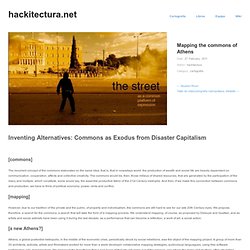
Welcome to D-Shape. Anish Kapoor_Concrete Printer. Collective intelligence. Types of collective intelligence Collective intelligence is shared or group intelligence that emerges from the collaboration, collective efforts, and competition of many individuals and appears in consensus decision making.
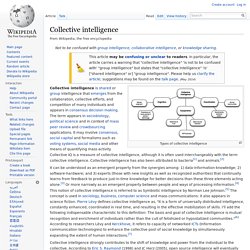
The term appears in sociobiology, political science and in context of mass peer review and crowdsourcing applications. Remix Architecture. Remix architecture methodology v0.84 Finally we translated the methodology into English so you can access now a the latest version documents here: RemixArchitecture-HUv0.84 (Hungarian) and RemixArchitecture-ENv0.84 (English).
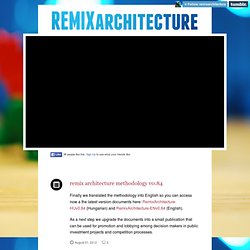
As a next step we upgrade the documents into a small publication that can be used for promotion and lobbying among decision makers in public investment projects and competition processes. remix architecture methodology After quite some exhausting work we compiled a methodology to run open license-based architecture competitions. The latest version of the document can be accessed here (in Hungarian), English translation is coming soon. workshop report We concluded a very successful workshop with invited experts in March 2011.
You can read the full report about the workshop in English and in Hungarian. photos by Hajdu Gáspár Remix Architecture workshop coming this week. By World Wide Web Foundation. Natural Earth. Blogs.OpenStreetMap.org. Open Architecture. Terms and Conditions Only 21 years old and above is eligible for loan application.

To preserve the confidentiality of all information you provide to us we maintain the following Privacy Principles. We only collect personal information that we believe to be relevant and required to understand your financial needs. By clicking "Submit" and providing your personal data, you consent to Credit Hub Capital contacting you via the telephone and email for the loan application purpose. We will only use any information collected as minimally as possible, mainly to assist us in customising and delivering loan packages that are of interest to our customers. We will not make unsolicited requests for customer information through email or the telephone, unless customers initiate contact with us. About - how we define design. Openstructures.net/ Blog. - The OpenStructures blog. Creative Commons. Participatory design.
Participatory design (originally Cooperative Design, also known in the USA as co-design) is an approach to design attempting to actively involve all stakeholders (e.g. employees, partners, customers, citizens, end users) in the design process to help ensure the result meets their needs and is usable.

Fink. The Fink project is an effort to port and package open-source Unix programs to Mac OS X.
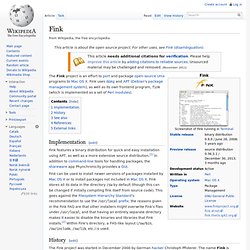
Fink uses dpkg and APT (Debian's package management system), as well as its own frontend program, fink (which is implemented as a set of Perl modules). Implementation[edit] Fink features a binary distribution for quick and easy installation using APT, as well as a more extensive source distribution.[1] In addition to command-line tools for handling packages, the shareware app Phynchronicity provides a GUI. History[edit] Christoph Pfisterer left the project in November 2001.[3] Since then, several people have stepped in and picked up support for Fink. The Fink community regularly add support for the latest versions of OS X with their release. See also[edit] References[edit] External links[edit]
Remix culture. Remix culture, sometimes read-write culture, is a society that allows and encourages derivative works by combining or editing existing materials to produce a new creative work or product.[2][3] A remix culture would be, by default, permissive of efforts to improve upon, change, integrate, or otherwise remix the work of copyright holders.
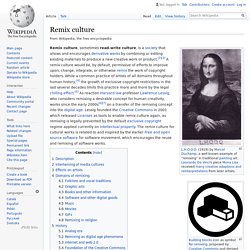
While a common practice of artists of all domains throughout human history,[4] the growth of exclusive copyright restrictions in the last several decades limits this practice more and more by the legal chilling effect.[5] As reaction Harvard law professor Lawrence Lessig, who considers remixing a desirable concept for human creativity, works since the early 2000s[6][7] on a transfer of the remixing concept into the digital age. Lessig founded the Creative Commons in 2001 which released Licenses as tools to enable remix culture again, as remixing is legally prevented by the default exclusive copyright regime applied currently on intellectual property.
Good Copy Bad Copy. Good Copy Bad Copy, A documentary about the current state of copyright and culture, is a documentary about copyright and culture in the context of Internet, peer-to-peer file sharing and other technological advances, directed by Andreas Johnsen, Ralf Christensen, and Henrik Moltke.

Geoff Mulgan "Openness and collective intelligence, its prospects and its challenges. Spatial Agency: About. Gun enthusiasts release open-source kits for 3D-printed Wiki Weapons. News: a group of libertarian activists in the U.S. plans to distribute open-source blueprints for homemade 3D-printed guns, provoking questions about the potential uses of the increasingly affordable technology.

Defense Distributed, the activist group led by Texas law student Cody Wilson, has just received $20,000 in funding for its Wiki Weapon project to create instruction kits for working guns. Individuals would be able to download the kits and use them to 3D-print their own weapons at home, sidestepping the need for a gun license. News of the project comes just weeks after another American hobbyist became the first person to successfully build and fire a 3D-printed gun. RepRap Self-Replicating 3D Printer: Fuel The Revolution by Relative Design. What is the RepRap Project? RepRap is an open-source desktop 3D printer capable of printing plastic objects. Since many parts of RepRap are made from plastic and RepRap can print those parts, RepRap is a self-replicating machine - one that anyone can build given time and materials. It also means that - if you've got a RepRap - you can print lots of useful stuff, and you can print another RepRap for a friend.
The RepRap project is all about making self-replicating machines, and making them freely available for the benefit of everyone. RepRap was the first of the low-cost 3D printers, and the RepRap Project started the open-source 3D printer revolution. How does the Reprap machine work? Look at your computer setup and imagine that you hooked up a 3D printer. Arcbazar.com. Virtual Worlds, Avatars, free 3D chat, online meetings - Second Life Official Site. Open source 3D virtual collaboration toolkit. Screenshots. Babblefrog@OSGRID Nebadon Key Gruin Balthazar.
Virtual world. The user accesses a computer-simulated world which presents perceptual stimuli to the user, who in turn can manipulate elements of the modeled world and thus experience a degree of telepresence.[6] Such modeled worlds and their rules may draw from the reality or fantasy worlds. Example rules are gravity, topography, locomotion, real-time actions, and communication. Communication between users can range from text, graphical icons, visual gesture, sound, and rarely, forms using touch, voice command, and balance senses.
Virtual worlds are not limited to games but, depending on the degree of immediacy presented, can encompass computer conferencing and text based chatrooms. Sometimes, emoticons or 'smilies' are available to show feeling or facial expression. Emoticons often have a keyboard shortcut.[9] Edward Castronova is an economist who has argued that "synthetic worlds" is a better term for these cyberspaces, but this term has not been widely adopted. History[edit]